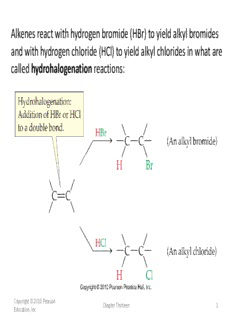
Alkenes react with hydrogen bromide (HBr) PDF
Preview Alkenes react with hydrogen bromide (HBr)
Alkenes react with hydrogen bromide (HBr) to yield alkyl bromides and with hydrogen chloride (HCl) to yield alkyl chlorides in what are called hydrohalogenation reactions: Copyright © 2010 Pearson Chapter Thirteen 1 Education, Inc. 2-Methylpropene could add HBr to give 1-bromo-2- methylpropane, but it does not; it gives only 2- bromo-2-methylpropane. Only one of the two possible addition products is obtained. Copyright © 2010 Pearson Chapter Thirteen 2 Education, Inc. Markovnikov’s rule: In the addition of HX to an alkene, the H attaches to the carbon that already has the most H’s, and the X attaches to the carbon that has fewer H’s. Copyright © 2010 Pearson Chapter Thirteen 3 Education, Inc. Hydration: The addition of water, in the presence of a strong acid catalyst, to a multiple bond to give an alcohol product. Copyright © 2010 Pearson Chapter Thirteen 4 Education, Inc. How Alkene Addition Reactions Occur • Reaction mechanism: A description of the individual steps by which old bonds are broken and new bonds are formed in a reaction. • Detailed studies show that alkene addition reactions take place in two distinct steps and involve a carbocation intermediate. • The addition of HBr to ethylene is an example. Copyright © 2010 Pearson Chapter Thirteen 5 Education, Inc. In the first step, two electrons move from the double bond to form a C-H bond. In the second step, Br- uses two electrons to form a bond to the carbocation. Copyright © 2010 Pearson Chapter Thirteen 6 Education, Inc. Alkene Polymers A polymer is a large molecule formed by the repetitive bonding together of many smaller molecules called . monomers Copyright © 2010 Pearson Chapter Thirteen 7 Education, Inc. Copyright © 2010 Pearson Chapter Thirteen 8 Education, Inc. Aromatic Compounds and the Structure of Benzene • Aromatic: The class of compounds containing benzene-like rings. • Benzene and other aromatic compounds are much less . reactive than alkenes Copyright © 2010 Pearson Chapter Thirteen 9 Education, Inc. Naming Aromatic Compounds • Substituted benzenes are named using -benzene as the parent. • • No number is needed for monosubstituted benzenes because all the ring positions are identical. Copyright © 2010 Pearson Chapter Thirteen 10 Education, Inc.
Description: